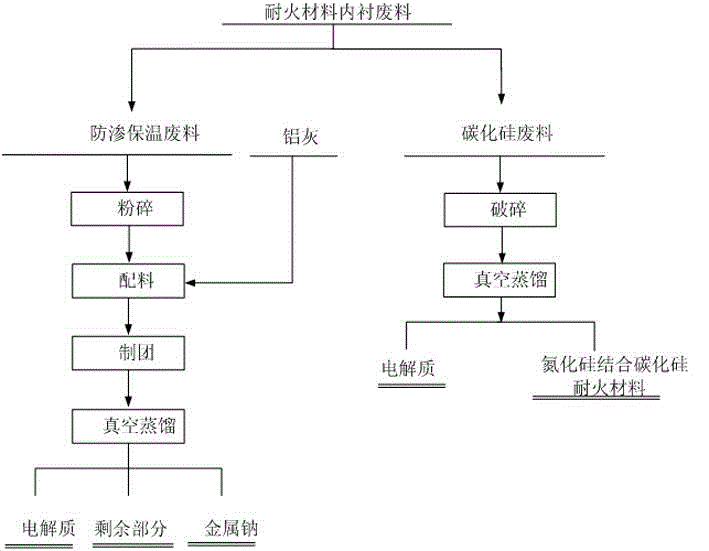Recovery treatment method of electrolytic aluminum ash and refractory material lining waste
A refractory material, recycling technology, applied in the direction of improving process efficiency, etc., can solve problems such as environmental impact, achieve the effect of low recycling cost, simple process, and good application prospects
- Summary
- Abstract
- Description
- Claims
- Application Information
AI Technical Summary
Problems solved by technology
Method used
Image
Examples
Embodiment 1
[0041] The anti-seepage and thermal insulation waste is crushed and ground until the particle size is below 80 mesh, then mixed with aluminum ash evenly, the mixing ratio is 1: (0.5~2) by weight, and then pressed into pellets; the pressure of pressing into pellets is 30~100MPa;
[0042] Place the pellets under the condition of vacuum degree ≤100Pa, heat to 1000~1400℃ for vacuum distillation, the vacuum distillation time is 1~10h, the electrolyte and metal sodium are crystallized on the crystallizer, and the main component of the remaining part is Al 2 o 3 and SiO 2 , as a raw material for the production of new anti-seepage materials;
[0043] The main components of the electrolyte are cryolite and sodium fluoride, and also contain aluminum fluoride, magnesium fluoride, calcium fluoride, potassium fluoride and lithium fluoride;
[0044] Crush the silicon carbide waste to a particle size below 60mm, then place it under the condition of vacuum degree ≤ 100Pa, heat it to 1000~1...
Embodiment 2
[0046] The anti-seepage and thermal insulation waste is crushed and ground until the particle size is below 80 mesh, then mixed with aluminum ash evenly, the mixing ratio is 1: (0.5~2) by weight, and then pressed into pellets; the pressure of pressing into pellets is 30~100MPa;
[0047] Place the pellets under the condition of vacuum degree ≤100Pa, heat to 1000~1400℃ for vacuum distillation, the vacuum distillation time is 1~10h, the electrolyte and metal sodium are crystallized on the crystallizer, and the main component of the remaining part is Al 2 o3 and SiO 2 , as a raw material for the production of new anti-seepage materials;
[0048] The main components of the electrolyte are cryolite and sodium fluoride;
[0049] Crush the silicon carbide waste to a particle size below 60mm, then place it under the condition of vacuum degree ≤ 100Pa, heat it to 1000~1200℃, vacuum distill at 1000~1200℃ for 1~10h, the electrolyte crystallizes on the crystallizer, and the rest is nitro...
Embodiment 3
[0051] The anti-seepage and thermal insulation waste is crushed and ground until the particle size is below 80 mesh, then mixed with aluminum ash evenly, the mixing ratio is 1: (0.5~2) by weight, and then pressed into pellets; the pressure of pressing into pellets is 30~100MPa;
[0052] Put the ball under the condition of vacuum degree ≤100Pa, heat to 1000~1400℃ for vacuum distillation (there is CaF in the anti-seepage insulation waste 2 ), the vacuum distillation time is 1~10h, the electrolyte and metal sodium are crystallized on the crystallizer, and the main component of the remaining part is Al 2 o 3 and SiO 2 , as a raw material for the production of new anti-seepage materials;
[0053] The main components of the electrolyte are cryolite and sodium fluoride;
[0054] Crush the silicon carbide waste to a particle size below 60mm, then place it under the condition of vacuum degree ≤ 100Pa, heat it to 1000~1200℃, vacuum distill at 1000~1200℃ for 1~10h, the electrolyte cr...
PUM
 Login to View More
Login to View More Abstract
Description
Claims
Application Information
 Login to View More
Login to View More - R&D
- Intellectual Property
- Life Sciences
- Materials
- Tech Scout
- Unparalleled Data Quality
- Higher Quality Content
- 60% Fewer Hallucinations
Browse by: Latest US Patents, China's latest patents, Technical Efficacy Thesaurus, Application Domain, Technology Topic, Popular Technical Reports.
© 2025 PatSnap. All rights reserved.Legal|Privacy policy|Modern Slavery Act Transparency Statement|Sitemap|About US| Contact US: help@patsnap.com

